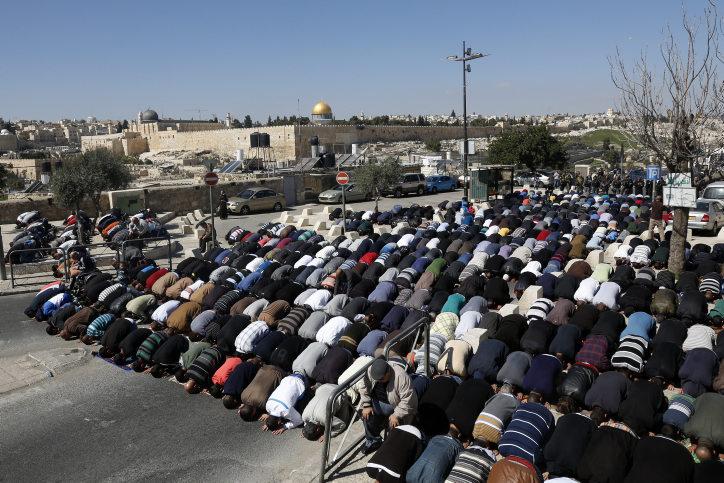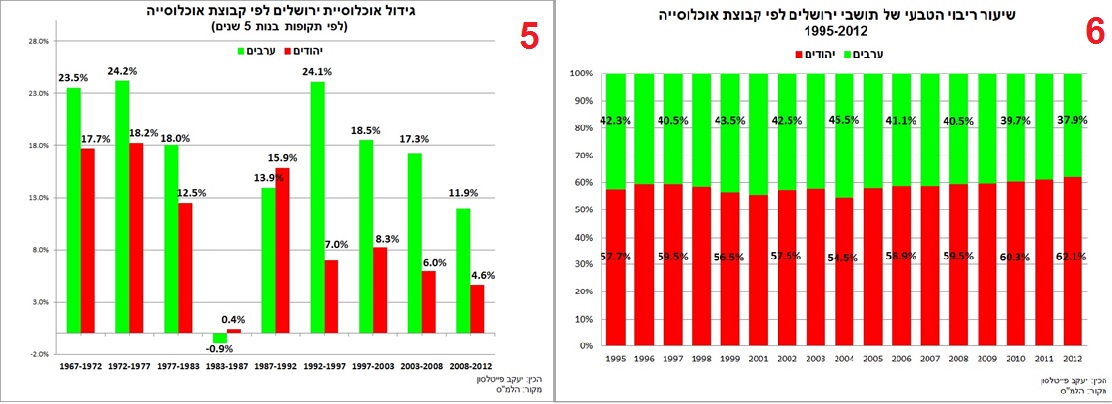The Jewish majority in Jerusalem is shrinking due to emigration. The solution? Expand Jerusalem's borders.
The eternal Jewish capital? Not necessarily: recent population numbers show that the historic Jewish majority in Jerusalem is in danger • A review of demographic data from the 19th century until today show that after years of a clear Jewish majority and a relatively higher Jewish birthrate, the Muslim Arab population is rapidly catching up • This is due primarily to positive Muslim immigration into the city and Jewish emigration from Jerusalem • The solution: expanding the city's municipal area and establishing Jerusalem as a metropolis

"Israel is acting systematically to change the character and identity of Jerusalem, strangling the Palestinians, Muslims and Christians, with the aim of pushing them out of the city." Thus PA Chairman Mahmoud Abbas in a complaint to the Pope during his visit to the Holy Land. He is not the first: the argument that the Israeli government is deliberately aiming to "Judaize" Jerusalem at the expense of the Arab and Muslim population.
The truth is quite the opposite: a close reading of the demographic numbers shows that Jerusalem is being increasingly Arabized, or to be more precise – Islamized. Thus, although the Jewish birthrate is higher than that of the Muslim and Christian populations, the negative emigration balance (Jews coming into the city minus those leaving it) of Jews from Jerusalem in the years 1995-2012 means than some 40% of this increase is cancelled out as they are no longer Jerusalemites. Meanwhile, the positive immigration balance of Arabs into the city has added some 9.7% to the Arab population's natural increase and enlarged their proportion in Jerusalem.
However, the data also shows that Jews leaving Jerusalem still stayed within the city's vicinity. Therefore, a possible and not unprecedented solution to this problem would be to expand Jerusalem's administrative borders and establishing Jerusalem as a broad metropolis which will ensure and entrench a Jewish majority in the capital.
A History of a Jewish Majority
According to demographic data published from the 19th century onward, Jerusalem had a clear Jewish majority for most of the last two centuries. Already in 1844, there were 7,120 Jews as opposed to 5,000 Muslims and 3,390 Christians, giving the Jews a relative majority over other groups. By 1887, the Jews had attained an absolute majority of 28,000 or 65.7% of the city's population, the remainder being 7,560 Muslims and 7,070 Christians. This trend remained stable: in 1911, the Jews numbered 59,700 or 66.6% of Jerusalem's population of 89,700.
As for the non-Jewish population, it's worth noting that the Christian-Arab population in Jerusalem was actually higher than its Muslim counterpart between 1891-1922. The number of Christian Jerusalemites continued to grow steadily from 1917; according to the British census of 1922, Christians were 23.4% of all Jerusalemites. Meanwhile, Muslims made up 21.4% and Jews 54.3% of the total population in the city. The Christian population peaked in 1946 at 31,300 residents, and since then has steadily declined.
The British conducted a second general census in 1931. The number of Jewish Jerusalem residents numbered 51,222 residents, bringing it up to 56.6% of Jerusalemites, the Christians down to 21.4% and the Muslims – 22%. Between 1937 and 1939, the Jews were more than 60% of the city's population; a Jewish mayor, Daniel Auster, was even elected. He also served as mayor between 1944 and 1945. Towards the end of the British Mandate in 1948, the British estimated that the Jews were 56.1% of the Jerusalem population, the Muslims 27% and the Christians 16.9%.

Past their Peak
From 1931, the Jewish population grew tenfold: some 515,000 in 2012. The Arab population grew 7.7 times, from 39,229 in 1931 to 300,200 in 2012. As we see from Diagram no. 3, in the twenty year period between 1970 and 1990, the Jewish population grew faster (an annual average rate of 2.84%) than in the next 22 years (an annual average rate of 1.38% during 1990-2012). By comparison, the Arabs grew at an annual average rate of 4.9% during 1970-1990 and 3% during 1990-2012.
Indeed, the Jewish population reached a peak of 75% in 1970 (Diagram no. 4). By 1983, they'd declined to 71.4%. By 1990, they rebounded to 72.1%, maintaining this proportion for the next three years. From 1993, the number of Jews began to decrease again, and by 2012 stood at just 63.2%.

The Jewish Birthrate is Higher, so why the decline?
However, when one examines the data category by category – births, deaths, natural increase, total fertility increase and the immigration/emigration balance within Jerusalem's municipal borders as they are today, and from the broad perspective of Jerusalem as a greater megapolis, a different and more complex picture emerges. According to the Israeli Bureau of Statistics, Jewish natural increase rose from 7,996 in 1995 to 11,960 in 2012 – a rate increase of 49.6%. Meanwhile, the Arab natural increase rose in the same period from 5,865 to 7,304 – or a rate increase of only 24.5%. From 2006 to 2012, the Arab natural increase rate grew by 7.8% while the Jewish natural increase rate grew 23.1%.
The Jewish share of general population natural increase, which stood at only 54.5% in 2004 rose to 62.1% in 2012 (Diagram no. 6). A check of the natural increase trends shown in diagram no. 8 shows than since 2005, Jewish natural increase is increasing every year, far outpacing that of the Arabs. This analysis means that the Jewish population should have consistently increased its numerical advantage over the Arab population. The Jews naturally increased by 163,093 between 1995 and 2012, 42.2% more than the Arab increase of 114,711 in the same period. But the actual Jewish permanent population in the city actually increased by only 98,088 people – 22% less than the Arab increase of 125,786. The Jewish population is thus smaller by 65,005 – and the Arab population 11,075 larger – than both populations would be if growth was solely dependent on natural increase.

So what's going on? The phenomenon of immigration to and from the city can explain this discrepancy. As mentioned above, the Jewish immigration balance during 1995-2012 was negative to the point of shaving off fully 40% of Jewish natural increase in Jerusalem. At the same time, the Arab immigration balance in Jerusalem is positive, adding 9.7% to Arab natural population increase and increasing their proportion in the city. As the table below shows, far from being pushed out and shrinking, the Muslim population is increasing, both relatively and absolutely.

Expand the Jerusalem Area to Ensure a Stable Jewish Majority
But it's not too late to stop this downward trend. Of the Jews who emigrated between 2000 and 2005 from Jerusalem, 31% moved to settlements in Judea and Samaria and another 21% went to other towns in the Jerusalem district. In 2006, no less than 76% of those leaving Jerusalem moved to towns near Jerusalem, and in terms of Greater Jerusalem remained within it.
Therefore, changing Jerusalem's municipal boundaries, which were arbitrarily drawn for a variety of reasons, could bring different results. A team headed by architect Shlomo Gertner made just such a proposal in the "Jerusalem 2050" master plan, done on the initiative of Kevin Bermeister. According to this plan, Jerusalem is conceived as a great metropolis stretching from the Dead Sea to Bet Shemesh and from Gush Etzion to Ramallah.

The closest example for such a plan comes from neighboring Jordan's plans for its capital of Amman. In 2007, the city's plan earned international prestige including the 'Asia Pacific' prize of "city of the year" in the category of city planning. By 2012, Amman had grown to 2.15 million residents, in a city sprawling over 1,680 square kilometers. The city is planned to encompass 6.51 million residents by 2025.
The "Jerusalem 2050" plan envisions the expansion of the city from 125 square kilometers to 2,500 square kilometers. By comparison, the area of Metropolitan Tel Aviv, including the Tel Aviv and central districts, stands at 1,500 square kilometers. Jerusalem's population would grow from 815,300 in 2012 to 5.23 million in 2050 – 3.324 million Jews and 1.906 million Arabs.
According to this scenario, the Jews would be 63.5% of the population of Greater in Jerusalem in 2050, with the Arabs constituting 36.5%. The increasing demographic trend in Jerusalem could thus serve as a solid basis for the development of Jerusalem as a central metropolis in the State of Israel. Mimicking our Jordanian neighbor would not only greatly increase the size of our capital but also greatly increase the proportion of Jews in that capital.
English translation by Avi Woolf.
To receive updates on new articles in English, join Mida on Facebook or Twitter or join our mailing list.





